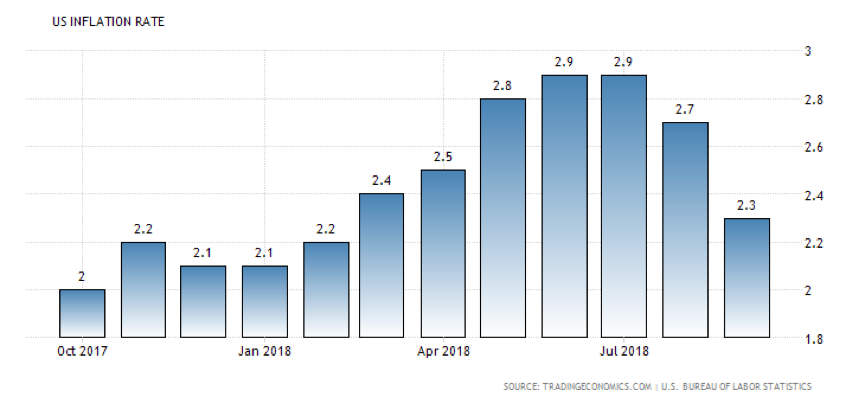The Benchmark 10-year treasury yield ended at 3.16 per cent in October 2018, the highest since 2011.
The risk in the yield reflects a fall in the price of bond. Because the yield represents the income as a proportion of the price, a fall in price increase the yield and vice versa. A Treasury bill is a certificate representing a loan to the federal government that matures in 3, 6 or 12 months. A Treasury note may mature in 1 to 10 years or more. A Treasury bond matures in more than 10 years. US treasuries are guaranteed by the US government and are considered one of the safest investments.
The jump in yield points to more selling pressure in US bonds. Investors have less intention to hold US bonds but why? In the case of US, the yield has risen because of concerns over the potential rising of the inflation due to the strong performance of the economy. This has been promoted strongly on the back of the risking consumer confidence, the growth of employment number, the tax cuts from the current government and buoyant corporate profits and revenues number.
Although it is a sign of good economy, for most of the investors, the rise of the US treasury yields is not necessarily good news.
Growing economy and potential concerns over inflation rate are more likely that interest rate will rise. This could be found by the recent Federal Reserve policy for rate hikes. Rising interest rates may increase the intention for the market to hold cash. The expectation of the potential drop in price of US government bonds also encourage such intention. Therefore, in order to attract investors, the price may need to drop further, and the yields may need to go higher.

With a strong economy and a higher than expected inflation, The Federal Open Market Committee (FOMC) raised the fed funds rate by a quarter point to 2.25 percent at its September 26, 2018, meeting. This is the eighth increase since the Fed began normalizing policy in December 2015. The Fed, under the former chairman Ben Bernanke, set a target for the fed funds rate in order to maintain inflation at 2% and maximize employment. This inflation targeting practice brought the Fed in line with other major Central Banks. Inflation is currently at 2.3% after hitting a high of 2.9% in July while the unemployment rate is kept at 3.7%. Rates hike is a sign of the Fed’s confidence in the strength of an economy, and stimulus measures that were imposed after the 2008 financial crisis could be rolled back. Along with the rate increase, the FOMC projects one more hike before the end of the year and three in 2019.

Furthermore, the settlement status of US dollar makes US government bond markets become the most important market in the world. For many financial assets, the price is based upon the price of US Treasury bonds. Considering US Treasury bond yields are the “risk- free” yields, how much premium that investors should make depending highlight upon how much “more” risk they are undertaking compared with US Treasury bonds.
Rising in US Treasury bond yields can mean a dwindling appetite for all forms of risk and an increasing demand for more risk premium from all forms of assets. That is why US Treasury yields matter. What happens here can have a big impact on everyone’s wealth.
US Treasury yield is a global benchmark for borrowing costs. Corporate will have to pay more to issue debt. Personal borrowers will need to pay more to borrow from the banks. As the yield rise, mortgage lenders can charge higher interest rates for mortgages. The 10-year treasury yield affects 15-year mortgages, while the 30-year yield impacts 30-year mortgages. The interest burden would weigh on the housing market since buyers would have to factor in higher interests in future.
The rising yields also affects the performance of developing markets. Years of cheap dollars has ended, and it is literally payback time as borrowing costs rise. With a strong economy, money is returning to the US. Some of the darlings of fund managers are now in intensive care as a result. Turkey’s economy is in a crisis after Trump slapped tariffs on its steel exports, an economy further aggravated by falling lira and high inflation. Argentina has decided to accept The International Monetary Fund (IMF) assistance with a $50bn loan agreement. Brazil, Argentina’s neighbor and South America’s largest economy, has its currency weakened to its lowest level in more than two years amid fears over the country’s economic and political outlook. South Africa plunged into an unexpected recession in the 2ndquarter of 2018, and unemployment is at 27.2%. Indian rupee is at an all-time low against the US dollar.
Looking ahead, the US economy’s performance is expected to continue, prompting the Fed to hike rates according to schedule. The Fed will keep its forecast of four hikes for this year, three for next, one for 2020, and in a new forecast, add about a half a hike in 2021. That would bring the fed funds rate to 3.50 percent. Of course, markets will always have their own self- adjustment technique. When the price drops to certain points that provide attractive yields, the investors will come in and the yield curve will be more stable, and the rest of the financial assets will settle to the “adequate” risk premium accordingly. However, it is very important to understand why US Treasury bond yields matter and how it affects your wealth. Any correction on the way to the final balance will for sure increase the volatility of financial assets.

